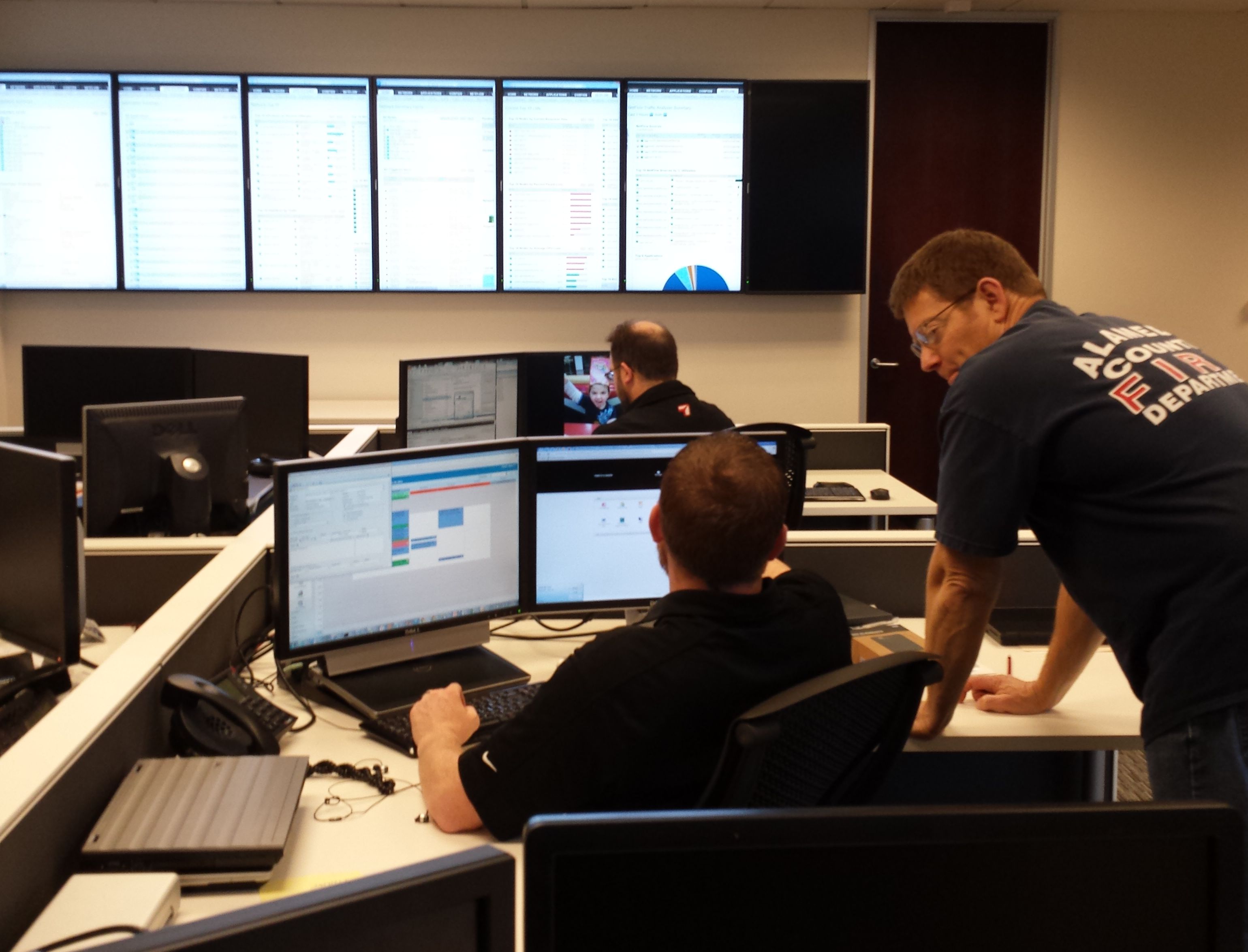New Trends in the Workforce
New Trends in the Workforce




Alameda County Workforce Investment Board completes new study on the future of work in the East Bay
The Alameda County Workforce Investment Board (ACWIB) is an influential policy board with a variety of funding sources to meet the workforce needs of local businesses, job seekers and educational institutions. Workforce Investment Boards were originally created through the Workforce Investment Act (WIA) of 1998. The act was passed to replace the Job Training Partnership Act with a new workforce development system designed to become more customer focused. New system goals under WIA were established to assist job seekers develop careers with information and services and to help employers find skilled workers from the local talent pool. Appointed by the Alameda County Board of Supervisors, our local ACWIB works closely with the Board of Supervisors to oversee programs, develop local plans and negotiate local performance.
ACWIB's current services are delivered through one stop centers where businesses and clients come to receive assistance. Through the one stop centers, workforce clients can receive training, education, employment leads and access to labor market information. Business clients receive training assistance, access to talented job seekers and specialized consulting services. We directly serve adults, dislocated workers who have lost their jobs due to permanent layoffs or plant closures, youth, as well as all local businesses. Our services aim to help our workforce clients enter into unsubsidized employment, retain jobs, develop skills and attain post-secondary degrees. Furthermore, in serving older and younger youth clients, youths are expected to receive diplomas, enter into post-secondary education programs and develop basic and occupational skills. In addition to delivering traditional services, ACWIB also conducts economic and labor market research to influence and inform local economic and workforce development in the region.
Workforce Analysis
A recent product of this last focus is a new report on workforce trends and needs in Alameda County. In 2011, ACWIB, in partnership with several other East Bay organizations including the East Bay Economic Development Alliance and the East Bay Community Foundation, helped produce a comprehensive analysis of the region's workforce titled Building on Our Assets. The report examined both trends in labor demand and issues surrounding the region's ability to maintain a qualified workforce needed to support projected demand. Because of the importance of this examination, ACWIB has prepared an update to some of the key areas of focus in this study that we now wish to share with the region. The following are a few key findings.
The analysis in the report studies the labor market and economic trends from the lens of the local industry clusters that are a particular focus of ACWIB. All of the industry clusters are competitive in specialized regions of the County. Overall, the Bio Science, Information Communication and Technology and Engineering (Professional, Scientific and Technical) industry clusters are the healthiest in terms of labor market demand, variety of employers, production of products and competitiveness. The analysis and trends indicate Healthcare, Energy and Construction are the second most competitive industry clusters while Transportation Logistics and Advanced Manufacturing are expected to decrease jobs in the next four years. A few main factors were used as research indicators throughout the report; occupations, youth and education, and employers and geography. These were key to the analysis as each of these factors play a major role in the operation and strategy of ACWIB programs:
-
Occupations Occupations in the report are analyzed from the lens of import and export. Each industry is unique in the variety and volumes of occupations needed for employers to stay competitive. As a County, our industry clusters are exporting Tier 2 and 3 occupations such as operators, repairers and clerks. This is concerning due to the loss of a significant number of jobs. The bright side of the export process shows opportunities and growth for a new class of workers. Growth of new jobs is driven by technological advancements and the automation of traditional jobs. New job markets within industries will eventually expand and develop new job classes that bridge the gap between creativity, design and technology. Most industries are shedding Tier 2 and 3 occupations except for Construction, Healthcare and Transportation Logistics. These industries are expected to add more Tier 2 and 3 occupations due to the nature of the industry responsibilities.
-
Youth and Education Understanding occupation shift is important in that it allows the region to properly prepare the education sector in terms of curriculum and education program adjustments needed to address the shift. ACWIB staff makes a point of staying informed of current youth performance measures such as internship opportunities and occupational demand analysis of regional education programs. Certain education programs such as Nursing and Computer Science cannot graduate enough students to keep up with current demand. Those occupations are recommended for import and it would be wise to develop local talent instead of importing these occupations from other regions or through the H-1B immigration process. ACWIB's forecasting and validation efforts are aimed at influencing proper content and capacity of our educational and training institutions, so that graduates have the relevant foundational skills and competencies to attach and advance through the multiple opportunities available in the regional economy.
-
Employers and Geography Employers are constantly looking for talented and skilled workers to fulfill their workforce demands. Alameda County is rich in the number of large and innovative employers as well recruitment possibilities of local job seekers. Each industry cluster has separate sets of specializations. Understanding the intricacies and specializations of each cluster allows our partners to leverage our information for the purposes of planning and placement. Aggregating our economic and workforce resources based by region makes sense because each portion of the county has unique combinations of jobs, populations and employers. ACWIB's future model to serve job seekers based on industry priorities within regions is a means to approach workforce development based on geography.
Workforce in the Future
The future of the East Bay Economy is a story based on geography, regional influences, retention of existing occupations and the development of a new working class. Our proximity to San Francisco and Santa Clara Counties allows companies in technology, science, finance and consulting to easily relocate to the East Bay. Companies are looking for new diverse and talented workers as well as more affordable rates for land, services and infrastructure. The regional influence of industry has consequences for the future growth and decline of jobs and companies. Regional economic influence can be seen by the expansion of consulting businesses in the north section of Alameda County and technology and manufacturing development in South County. In the North, proximity to San Francisco helps drive the consulting, professional and engineering service sectors. Land is affordable and transportation networks allow businesses and workers to easily move and enter into Oakland, Berkeley and Emeryville. Technology and manufacturing industries are growing in South County partly because of the proximity to Santa Clara County. Silicon Valley startups and large Information Technology companies are venturing north into Alameda County to access a diverse talent pool and take advantage of affordable infrastructure, land costs and network of services.
Companies and workers from all parts of the Bay Area are becoming more interested and attracted to opportunities in the East Bay. The fastest growing industries in the region are Information Communication Technology, Bio Science and Engineering services. These catalyst industries are responsible for growth, innovation and expansion. The companies attract worldwide talent and do not often advertise for entry to middle level positions. Instead of advertising for entry to middle level jobs, they rely on technology and automation to trim workforce responsibilities. Companies in these growing industry clusters are advertising for a new working class with a mix of creativity, science, technology and computer related skills. Job seekers with business, managerial and financial backgrounds will also be in demand.
Retention of entry and middle skilled jobs in the region is a serious concern. Many of these jobs are being exported or automated to reduce costs. Several industry clusters such as Transportation Logistics, Advanced Manufacturing, Energy and Construction will continue to retain and hire more entry to middle level jobs. From the point of view of Transportation Logistics, our region is positioned as a major transportation hub that will consistently produce many jobs. Other industry clusters in conjunction with the transportation cluster will ensure a high number of entry to mid-level occupations will stay in the region. Many of the entry to middle level jobs provide foundational support for companies and should prove to be difficult to export or automate.
In general, most industries are hiring middle to upper level occupations. High job growth will occur in the creative classes that are technologically inclined and attuned to science and mathematics. Occupations requiring experience and skills in finance, business, management and advertising will continue to grow as well. Industries are advertising for individuals to develop new products, processes and strategies to allow companies to become world leaders. In the technological and bio science sectors, many of the world's industrial giants are located in the Bay Area. As a region, we are not providing enough talented workers through our educational and professional development institutions to meet demand. Technology, finance and science companies are lobbying to increase the limit of foreign workers allowed to enter the country for work. While it is important to fulfill the industry demands of these competitive companies with worldwide talent, it is equally important for the region to work collaboratively with companies to develop a skilled workforce in the region.
The Role of Information
Information in the digital age is being produced, captured, analyzed and communicated in a variety of ways. Leveraging information as a tool to develop programs and policies in conjunction with traditional planning methods is an extremely powerful option that will continue to grow and expand.
The world is becoming more interconnected through the expansion of digital products and media. These outlets and products produce large amounts of information available for collection and analysis. The connection to big data and analysis is especially important in the world of workforce and economic development where new events trigger changes in supply and demand. With accurate information, we are able to develop better plans for our programs that target specific pockets of jobs and industry growth in the region. Access to information allows us to target our training programs towards industry demands, place clients into growing occupations and assist local employers. Our goal is to allow information to initiate local planning conversations and shape our programs and policies.
Much of the information we receive is live and changes based on regional economic patterns. These patterns are shaped by a variety of factors such as inventions, company mergers, layoff events and environmental changes. Keeping informed on the fluctuation of economic patterns allows us to be flexible during our service delivery. To serve the continuously evolving nature of the local economy, we need to be equipped with tools that tell us a comprehensive economic story.
Specific uses of the information include assisting the ACWIB's engagement with businesses, developing training programs and targeting employment opportunities for our clients by occupation class. Data analysis allows our business service representatives to properly target hiring companies within our industry clusters. The data driven approach allows us to focus on dozens of attractive companies filtered from an original listing of tens of thousands of employers. Our staff time and resources are allocated to high value businesses through the use of information. Understanding the demand for occupations allows us to develop specific training cohorts to enter into open positions. We can work with specific education and training programs to meet current industry demand. Access to information about open positions in the area allows us to properly match our diverse job seeker population with appropriate positions. Lastly, we are able to find employment opportunities from the lens of three different occupation classes. These include entry, middle and upper level jobs. Specific industries and geographies demonstrate hiring patterns for the three different classes. Knowing these patterns, we can better match our diverse job seeker population to appropriate open positions.
We hope our work here will be of interest to those who want to continue the development of a vibrant East Bay economy. Toward that end we invite you to find out more about what ACWIB can offer to help build the region's workforce toward a successful future. Visit us at www.ACWIB.org.
Also in this issue...
- Zeiss X-ray Microscopes Reveal Mysteries & Aid in Research
- Wood Rodgers Offers Distinctive Development Services
- Business Bits
- Childhood Passion Leads to Stellar Career
- Agency Provides Therapists to Local Schools, Offices
- NanoEnTek Eager to Tackle U.S. Market
- New Trends in the Workforce
- Bike to Work Day Gets Commuters on Two Wheels
- Bras for the Cause Puts the Fun in Fundraiser
- Local Group Lends Hand for Independent Living
- Hacienda Index
- Calendar




